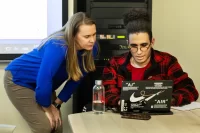
That makes scents: Bates, Pitt scientists propose approach to categorizing odors

What the nose knows, scientists at Bates and the University of Pittsburgh are learning to classify. (Phyllis Graber Jensen/Bates College)
Using advanced statistical techniques, researchers at Bates and the University of Pittsburgh have developed an approach to systematically describing smells.
This work may help guide future studies pertaining to how smells are represented in the brain. The Bates-Pitt research suggests that there are about 10 basic categories of odor — including fragrant, fruity, minty, lemon and, albeit with different odor profiles, two categories for “sickening.”
Senses such as hearing and vision can be discussed in terms that most people understand and that are tied to measurable physical phenomena. But the sense of smell, or olfaction, has thus far not lent itself to such a systematic understanding of what smells we perceive and how those perceptions relate to physical phenomena.
- Titled “Categorical dimensions of human odor descriptor space revealed by non-negative matrix factorization,” Castro, Ramanathan and Chennubhotla’s research appears in the open-access online journal PLOS ONE. See the article.
“It’s an open question how many fundamental types of odor qualities there are,” says Jason Castro, assistant professor of psychology and neuroscience at Bates and a former Pitt postdoctoral fellow. “This is in striking contrast to olfaction’s ‘sister sense,’ taste, where we know that five basic qualities seem to organize sensations.”
Castro and Chakra Chennubhotla, assistant professor in the Department of Computational and Systems Biology at the University of Pittsburgh, led the research. A third collaborator was Arvind Ramanathan, a computer scientist at Oak Ridge National Laboratory.
Working with a standard set of olfactory perception data, Andrew Dravniek’s 1985 Atlas of Odor Character Profiles, the Bates-Pitt team was the first to apply a mathematical method called non-negative matrix factorization (NMF) to achieve “dimensionality reduction” — the simplification of information into coherent categories, similar to the way compressing a digital audio or image file reduces the file’s size without, ideally, compromising its usefulness.

Chakra Chennubhotla, assistant professor in the Department of Computational and Systems Biology at the University of Pittsburgh.
“What NMF is good at,” says Chennubhotla, “is dividing a dataset into its constituent parts. You have to give hints for how many parts you may expect to find, but otherwise you let the data decide.
“NMF has been successfully used in many other areas including the financial world and the processing of still images and videos.”
From the data, the team identified 10 basic odor qualities: fragrant, woody/resinous, fruity (non-citrus), sickening (decayed), chemical, minty/peppermint, sweet, popcorn, sickening (pungent) and lemon.
An intriguing aspect of the work is that the different qualities seem to be associated with different chemical features, though Castro is quick to stress that more research is necessary on this front.
In ongoing work, the researchers are now approaching the problem from the other direction, applying the current research to a bank of chemical structures in an attempt to predict how a given chemical is going to smell.
“That’s something that nobody’s really done with any kind of compelling accuracy,” Castro says. “And obviously perfume companies, flavor and fragrance companies, are really interested in doing that well.”





